Maternal mortality rate: India

This is a collection of articles archived for the excellence of their content.
|
Contents[hide] |
The extent of the problem
2010- 20, state wise
Rema Nagarajan, Dec 7, 2022: The Times of India

From: Rema Nagarajan, Dec 7, 2022: The Times of India
India has brought down its maternal mortality ratio (MMR) to less than a quarter of the levels about two decades ago, outperforming almost all of its erstwhile peers, including neighbours like Bangladesh, Pakistan and Bhutan. The progress has been steady, an analysis of data from 2007-09 to 2018-20 shows.
At the turn of the century, India had a maternal mortality ratio of 400. Since the sample survey in 2007-09 when India recorded an MMR of 212, it fell by 16% to 178 over a three-year period by 2010-12 and by 27% to 130 by 2014-16. Between the SRS surveys in 2014-16 and 2018-20, MMR fell by 25% to 97, thus showing a steady trend of declining maternal mortality.
However, the rate of decline in states such as West Bengal, Haryana, Madhya Pradesh and Punjab was lower than the national rate. Also, different Indian states are at vastly different levels of MMR straddling the spectrum from least developed countries to the developed world.
India’s MMR (the number of maternal deaths during a given period of time per 100,000 live births) at 97 in 2018-20 is at the level of Nicaragua, alow middle income country, among the least developed countries in Central America. However, the current MMR of 167 in a state like Uttar Pradesh is more or less at par with that of war-torn Yemen in 2017 according to Unicef data.
Assam’s MMR is at the level of Gabon and Odisha’s is close to Namibia. Kerala, with an MMR of 19, is at the level of the US, according to official data, having achieved a reduction from 46 in 2014-16. Maharashtra matches Mexico while Telangana has Vietnam for company.
India’s MMR is less thanhalf of the world’s. Global MMR in 2017 was 221. With India accounting for one fifth of the world’s annual child births, improvement on this parameter in India impactsthe global value. With the steady improvement, India is on target to achieve the sustainable development goal (SDG) of 70 by 2030.
One major factor contributing to the dramatic decline has been that while in 2005-06 only 40% of births happened in a medical institution, over the next decade this proportion had been raised to 79%and then to 89% by 2019-21.
Later marriages and female education have contributed too. Almost half (over 47%) of women in the 20-24 age group were married by the age of 18 in 2005-06. This fell to 18% by 2015-16 and further to 15%, according to the recent National Family Health Survey (NFHS) of 2019-21. Only about 55% of women were literate in 2005-06, compared to 81% in 2015-16 and 83% by 2019-21.
While much has been achieved, Sri Lanka’s MMR of 36 and that of states such as Kerala, Maharashtra, Telangana and Andhra Pradesh show that other states in India too can improve, and rapidly. Kerala, for instance, had an MMR of 195, about twice the national level now, less than two decades back.
2011> 2016: further improvements
Sushmi Dey, June 7, 2018: The Times of India
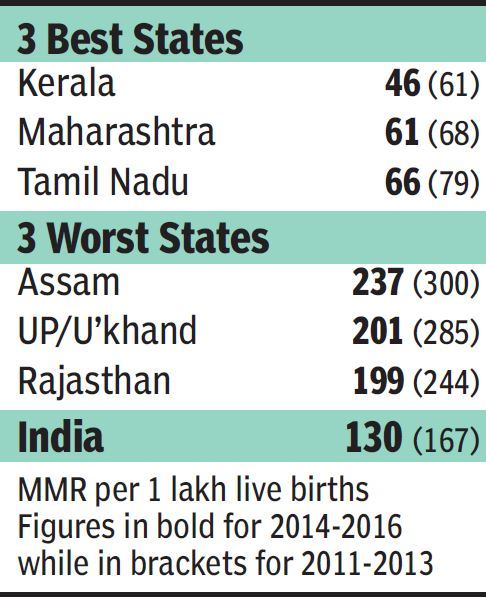
From: Sushmi Dey, June 7, 2018: The Times of India
HIGHLIGHTS
Maternal deaths in India have reduced from 167 in 2011-13 to 130 (per 100,000 live births) in 2014-16
Maternal and child mortality and morbidity are considered key health indicators as they reflect the state of female healthcare
India has registered significant improvement in an area where it has lagged — maternal deaths have reduced from 167 in 2011-13 to 130 (per 100,000 live births) in 2014-16 with Kerala leading the table, according to new data released by the registrar general of India.
The maternal mortality ratio (MMR) provides a measure of the quality of safe deliveries and maternal care and India's healthcare services have lagged in this respect in comparison to neighbours like China, Sri Lanka and Maldives.
The decline has been most significant in the "empowered action group (EAG)" states and Assam, from 246 to 188, in the last three years. These are states where economic and development indicators are a particular concern, like Bihar, Chhattisgarh, Jharkhand, Madhya Pradesh, Odisha, Rajasthan, Uttarakhand and Uttar Pradesh.
Among the southern states, the decline is from 93 to 77 and in the other states from 115 to 93. The heartening statistics point to steady gains, likely linked to more focused efforts to improve maternal care and rising number of institutional deliveries and more attention to health protocols.
As compared to other states, MMR continues to be substantially high in EAG states despite the drop. Assam still recorded the highest maternal death ratio at 237, though down from 300 in 2011-13. Similarly, UP and Uttarakhand registered an MMR of 201, down from 285 in the last three years.
Kerala has turned in a stellar performance, in what can be seen as evidence of a robust public health system as well as high levels of education and awareness, with the lowest MMR of 46, falling from 61 in 2011-13.
Apart from Kerala, Tamil Nadu and Andhra Pradesh also performed well after recording MMR of 66 and 74, respectively.
Maternal and child mortality and morbidity are considered key health indicators as they reflect the state of female healthcare. Over the years, the government has taken initiatives to improve these health indicators. India has reduced its maternal mortality by over 69 per cent since 1990, though it still has some catching up to do with better-performing Asian countries. Despite this, India, along with Nigeria, accounted for one-third of the global maternal deaths in 2015.
India ranks 129 among 184 nations on maternal mortality and 145 out of 193 nations on infant mortality, according to the World Bank.
The gap in maternal healthcare between urban and rural areas is often blamed for the overall poor scores and the inequalities are also evident through varying maternal mortality ratios across country.
The health ministry has introduced as well as expanded coverage of various schemes to address these challenges, with its main focus on remote areas. It has also started some new schemes to provide care to women at different stages of pregnancy and increase institutional deliveries to prevent deaths.
"After the launch of the National Rural Health Mission in 2005, significant improvements have taken place in building the health infrastructure in the country," a senior health ministry official said.
The Janani Suraksha Yojna, or the maternity benefit scheme, has brought about a surge in institutional deliveries and financial uptakes in most states. Besides, the Rashtriya Kishor Swasthya Karyakram focuses on adolescent health and improving nutritional status and "Partnerships and Opportunities to Strengthen and Harmonise Actions for Nutrition (Poshan)" aims at community-based management of malnourished children.
Globally, the annual number of maternal deaths per 100,000 live births dropped by 44 per cent between 1990 and 2015 — from 385 to 216. The sub-Saharan African region accounted for an estimated 66 per cent (201,000) of global maternal deaths, followed by southern Asia at 22 per cent (66,000 deaths). In fact, only 5 per cent of the world's countries accounted for 59 per cent of the total maternal deaths globally.
2015: Considerable improvement
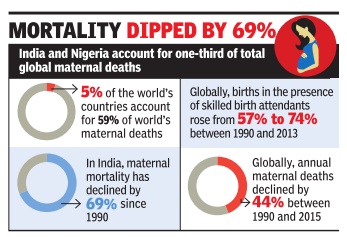
The Times of India
Despite maternal mortality rate coming down to half worldwide since 1990, India accounts for 15% of such casualties during pregnancy and childbirth with 45,000 maternal deaths in 2015, according to a new global report by Lancet which points out international as well as national disparities in maternal healthcare services.
Despite making significant progress in reducing its maternal mortality by 69% since 1990, India along with Nigeria accounted for one-third of the global maternal deaths in 2015, the report says while attributing it to a yawning gap in maternal healthcare between urban and rural areas.
The report also highlights global inequalities by pointing at varying maternal mortality across countries. It shows that the gap between the group of countries with the lowest and highest rates of maternal mortality has doubled between 1990 and 2013.
Globally , the annual number of maternal deaths per 100,000 live births dropped by 44% between 1990 and 2015, from 385 to 216. The sub-Saharan African region accounted for an estimated 66% (201,000) of global maternal deaths, followed by southern Asia at 22% (66,000 deaths). In fact, only 5% of the world's countries accounted for 59% of the total maternal deaths globally .
“However, alongside the increasing gaps between different countries, the potential for growing inequities within countries also exists, spatially in terms of rural and urban areas or remote districts, and between population subgroups,“ the report further says.
The report a series of six papers published in the Lancet analysed different aspects and issues of maternal health globally . Despite improvement in coverage of institutional deliveries and skilled birth attendants, India has twice missed its millennium development goals to reduce maternal mortality rate by three quarters. Currently , India's maternal mortality rate stands at 174 and to achieveits next target, it needs to reduce it to 103.
Experts say that coverage of life saving interventions and inequity are two of the biggest hindrances in India for improving maternal healthcare.
The health ministry has introduced as well as expanded coverage of various schemes to address these challenges, with its main focus on remote areas . It has also started some new schemes to provide care to the pregnant women at different stages of pregnancy .
2015> 18
Rema Nagarajan, July 18, 2020: The Times of India
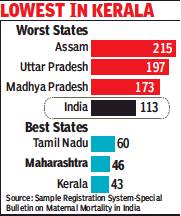
From: Rema Nagarajan, July 18, 2020: The Times of India
India’s maternal mortality ratio (MMR), a key health system indicator, dropped to 113 in the 2016-18 period from 122 in 2015-17, according to the latest data released by the office of the registrar general of India. One of the UN’s sustainable development goals is to reduce MMR, defined as the number of maternal deaths during a given time period per 100,000 live births, to less than 70. India’s MMR used to be about 556 in 1990 and 254 in 2004-06.
Among some of the states which saw an increase in MMR, the most alarming increase was in Chhattisgarh, where it went from 141 in the 2015-17 survey to 159 in the current one. Uttarakhand, too, saw an increase from 89 to 99, Punjab from 122 to 129, and West Bengal from 94 to 98.
Kerala reports lowest maternal deaths in India
Assam continues to be the state with the highest MMR over the last three sample surveys conducted, followed by UP and MP. Over the same period, Kerala, Maharashtra and Tamil Nadu, in that order, continue to have the lowest MMR. While Maharashtra and Tamil Nadu have been steadily reducing their MMR, Kerala’s MMR went up slightly from 42 in the last survey to 43, though it remained the lowest in the country. The main causes for maternal mortality are severe bleeding, mostly after childbirth, infection post childbirth, high blood pressure causing seizures or complications during childbirth, and unsafe abortions. Thus, it was believed that these could be addressed if deliveries happened in institutions where trained health personnel would be available, resulting in a huge government push to increase institutional deliveries, which were just 43% in 2004. By 2018, institutional deliveries constituted 83% of all childbirths in India.
While this push seemed to have paid off initially in bringing down MMR substantially, the increase in institutional deliveries in many states is no more showing a corresponding decrease in maternal mortality. In Assam, for instance, institutional deliveries are almost 83%, much higher than say Bihar with just 70% or Jharkhand with just 61.7%. Yet, MMR in Assam is 215, while it is 149 in Bihar and just 71 in Jharkhand. In Karnataka, despite institutional deliveries being as high as 97.6%, its MMR of 92 is higher than that of Haryana (91) or Telangana (63) where institutional deliveries constitute only 86% and 94%, respectively.
Experts have published papers on the poor quality of healthcare offered in many of these institutions, both public and private, towards which women have been pushed — through cash incentives for health workers and pregnant women themselves opting for institutional delivery.
2017-19
March 14, 2022: The Times of India
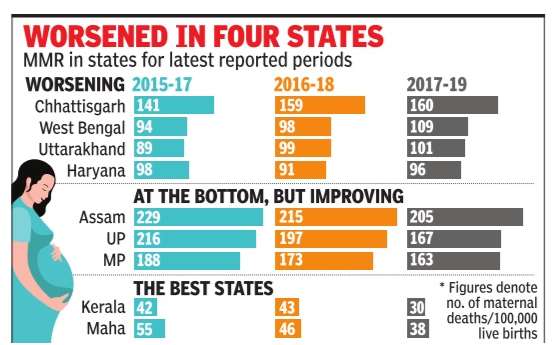
From: March 14, 2022: The Times of India
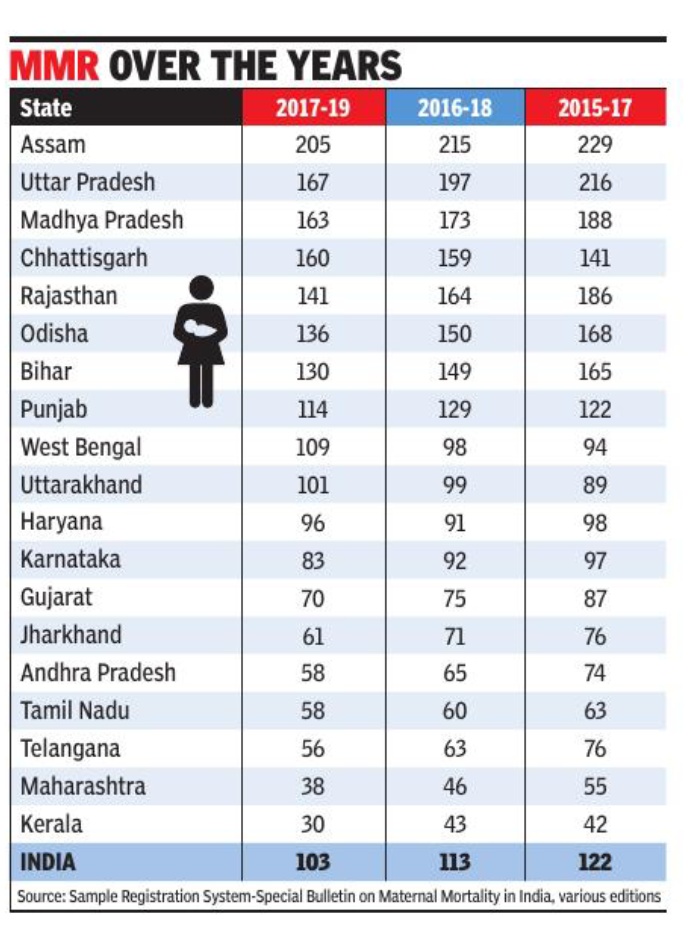
From: March 14, 2022: The Times of India
India’s maternal mortality ratio (MMR) improved to 103 for the period 2017-19, but the ratio has worsened in states such as West Bengal, Haryana, Uttarakhand and Chhattisgarh, according to official data just released.
With the MMR continuing to drop for the third year running, India looks set to achieve the sustainable development goal of bringing it to 70 well before the target year of 2030. The ratio was 122 in 2015-17.
MMR, a key health system indicator, is the number of maternal deaths per 100,000 live births during a given period. India’s MMR was about 556 in 1990 and 254 in 2004-06.
Populous states like UP, Rajasthan and Bihar showed huge improvement, helping India stay the course of steady improvement. The decline in the ratio in these three states from 2016-18 is by 30, 23 and 19 points, respectively, though from very high levels.
Maternal mortality ratio worst in Assam, UP & MP
Bengal’s MMR Rises 10 Points, Stands At 109
Despite significant improvement, Assam, Uttar Pradesh and Madhya Pradesh, in that order, continue to be the states with the highest maternal mortality ratio (MMR). West Bengal showed a shocking increase of 10 points in MMR, jumping from 98 to 109. While the sudden jump might be surprising, the state has seen a steady worsening over the last three surveys. Chhattisgarh and Uttarakhand show marginal worsening, while Punjab after worsening in the last survey has improved in the latest one. Haryana has joined the club of worsening states.
In the list of three states with the lowest MMR, Telangana replaced Tamil Nadu to join Kerala and Maharashtra. Barring Karnataka at 83, the southern states and Maharashtra have the lowest MMR in the country, ranging from 30 in Kerala to 58 in Andhra Pradesh and Tamil Nadu.
After stagnating or showing marginal worsening, Kerala’s MMR has improved dramatically from 43 to 30, recording very high improvement in maternal health between two consecutive surveys, an achievement that is considered difficult when a state has already achieved a low level.
Many developed countries have successfully brought down MMR to single digits. Italy, Norway, Poland and Belarus have the lowest MMR of two, while it is seven in both Germany and the UK, 10 in Canada and 19 in the US. Most of India’s neighbours — Nepal (186), Bangladesh (173) and Pakistan (140) — have a higher MMR. However, China and Sri Lanka are way ahead with MMRs of 18.3 and 36 respectively.
2000-20
February 8, 2024: The Times of India
New Delhi : The maternal mortality rate in India has declined from 384 per one lakh live births in 2000 to 103 in 2020, whereas global MMR has declined from 339 in 2000 to 223 in 2020, as per the UN Maternal Mortality Estimation Inter-Agency Group report. The average annual rate of reduction in global MMR during the 2000-2020 period was 2.07% while India’s MMR has declined by 6.36%, which is higher than the global decline.
This data from the report was shared by WCD minister Smriti Irani in response to a question in Rajya Sabha. RS member Jose K mani sought to know if govt had any justification for the report which stated that India is among 10 countries that make up 60% of global maternal deaths.
Irani also shared data on maternal deaths as per the Registrar General of India, which showed it was 130 during (201416); 122 during (2015-17); 113 during (2016-18); 103 during (2017-19) and 97 during (2018-20).
2018- 2020: The best and worst states

From: August 25, 2024: The Times of India
See graphic:
The Maternal mortality rate in India’s best and worst states: 2018- 2020
See also
Maternal mortality: South Asia
Maternal mortality rate: India